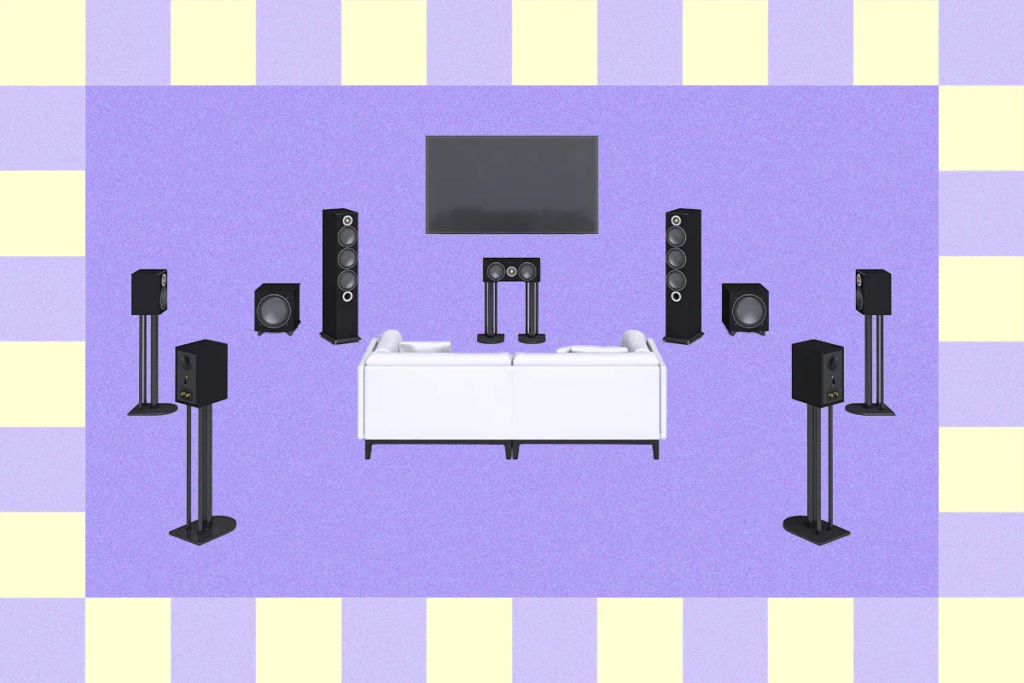George Lucas famously said “sound is 50 percent of the movie-going experience,” and he ought to know. But what if you want to bring the full excitement of the movies home? How can you ensure you’re getting an audio performance that will do justice to the pictures you’re watching?
By investing in a surround sound setup, that’s how. A well-sorted surround sound system can offer the cinematic scale and sonic immersion that makes movie night an authentic event. Sure, you could choose one of our best soundbars and make a significant improvement on your TV’s sound, but if you’re looking to get closer to the movie theater experience at your home, a surround sound setup is what you need.
Below you’ll find everything you need to know about getting started with surround sound, and the kind of setup you will need in order to achieve it. Once we’re done, you might never feel the need to set foot inside a cinema again.
What Is Surround Sound?
This shouldn’t take too much explaining, because the answer is in the question: surround sound is an audio set-up designed to surround the listener with sound. Unlike watching TV or listening to a stereo system, where sound is coming from in front of your seated position, a surround sound setup uses multiple speakers arranged in as close to a circle as is possible around your seat.
This is the reason surround sound is sometimes referred to as “multichannel,” because it splits sound into more individual “channels” of sound than the two channels that constitute a traditional stereo setup. Each of these channels carries different audio information—and usually to an individual speaker too.
Naturally, a surround sound setup also requires more channels of sound to be amplified—you can’t attach more than two speakers to a stereo amplifier, so you’ll need an amplifier that can deal with the number of speakers in your home cinema setup.
Common Surround Sound Setups: 5.1 and 7.1-Channel Systems
You may have seen surround sound setups described numerically—most commonly as 5.1-channel or 7.1-channel surround sound systems, but sometimes, in the case of spatial audio setups, with an extra number on the end, like 5.1.2 (more on this shortly). Simply put, these numbers refer to the number of speakers in the system.
For example, you can express a stereo system as 2.0. This means it consists of the “left” and “right” channels we’re all familiar with—and if they’re carefully positioned, these two speakers will create a convincing stereo image. This makes it possible to perceive a soundstage, and to understand the position the individual elements of a recording, like voices or instruments, occupy within it.
A surround sound system tends to consist of a minimum of five speakers—this is the “5” in the “5.1” designation. The five speakers consist of stereo-style left and right channels at the front, but with a dedicated ‘center’ channel sitting between them. Ideally the center speaker will be positioned as close to the TV or projector screen as possible—this is because the overwhelming majority of dialogue in a movie soundtrack is routed through the center channel. There’s nothing more disconcerting than the sound of voices being separate from the pictures of the mouths that are producing them.
The other two speakers are the surround channels, again arranged in a “left” and “right” layout— but this time positioned to the side of your seated position and, ideally, slightly behind it. With this rough circle of five speakers surrounding your seating position, the sensation of sonic movement where on-screen motion and/or special effects are concerned, is much more pronounced (and, consequently, much more immersive) than when all the sound is delivered in front of you.
If you have the space (and the budget), you can push this up to a 7.1-channel system, where—you’ve guessed it—there are an additional two speakers to accommodate. In this setup, speakers six and seven are designated as “rear left” and “rear right” channels, and are designed to be positioned directly behind the listener. They then work in conjunction with the surround channels to create an even more unified 360-degree surround sound layout. The scope for accurate movement and positioning in the soundfield is obviously increased by the presence of these two additional channels of sound.
As for the “.1”? This refers to the low frequency effects (LFE) channel—much more commonly known as a subwoofer. This speaker deals exclusively with the lowest, bassiest sounds in a soundtrack, and is designed to deliver all the rumble, punch and power that movie soundtracks are so often very fond of.
Creating the deepest, bassiest sounds demands the movement of a lot of air, of course, and so subwoofers tend to be boxier than the speakers they accompany, as this allows them to be fitted with necessarily large drivers. At least the fact that low frequencies are much less directional than the rest of the frequency range, and therefore aren’t so willing to betray the position of the speaker that’s producing them, means that subwoofers are far less picky about their position in your surround sound setup, though.
Understanding Height Channels
Remember those extra numbers we mentioned at the end of the 5.1 and 7.1 setups? If you see those—most commonly 5.1.2 or 7.1.4—that means the system includes height channels, which are the channels you’ll need for the most effective spatial audio setup.
There’s no way you haven’t heard at least a little about spatial audio. Its ubiquity, especially in its brand-specific Dolby Atmos and DTS:X guises, is increasing on a seemingly daily basis, to the point that even headphones and smartphones, not to mention soundbars, promise a spatial audio experience that will forever change the way you listen.
Of course, promise is not the same as deliver—and just as with those soundbars that want to replicate the effects of a surround sound setup, it’s difficult in the extreme to create a sensation of spatial audio without the physical equipment necessary.
For home cinema, the words ‘spatial audio’ can confidently be swapped for ‘3D sound’. Unlike a 5.1 or 7.1 surround sound setup, which creates a circle of sound around the listener, a spatial audio system creates a dome, where sound is delivered from above, as well as from the front, sides and rear.
Imagine your 7.1-channel system, and add four overhead speakers that have their own discrete information contained within the soundtrack. What you have now is a 7.1.4 system, and any content that’s been mixed specifically for a spatial audio system has an extraordinary amount of scope for the steering of effects within the dome of sound the system can create.
The best way to achieve a spatial audio effect from height channels is by precisely positioning speakers into the ceiling of your home cinema room. I hardly need to tell you that is is a relatively complicated process, and never what you might be tempted to call “cheap.” That is why a number of loudspeaker brands have developed upwards-firing modules that are designed to sit on top of some of the speaker cabinets in your surround sound setup, and reflect sound off the ceiling in an effort to replicate the effect of overhead speakers. It’s a similar method to those spatial audio soundbars with drivers that face upwards—but obviously on a larger scale.
Does Surround Sound Actually Sound Better?
For the most dedicated movie fans, the answer here is undoubtedly yes—if you choose to invest in a surround sound setup, the sound that accompanies the movies you watch will be completely transformed. Whether it’s right for you, your budget and your space is a very different question, and it’s worth weighing up the other options for improving your home cinema sound before you invest.
Surround Sound vs Stereo Sound
Which is “better” between surround sound and stereo sound isn’t really an absolute here—it’s a bit like trying to decide which is better between apples or onions. It’s fair to say, though, that if your primary interest is in home cinema rather than in music, a surround sound setup is going to bring you far closer to the objectives of the filmmaker (and their sound designer) than a stereo alternative has a hope of doing.
All movie soundtracks will have been mixed to be delivered by a surround sound setup, and that’s true whether you’re getting your movie from a streaming service or via legacy media such as 4K Blu-ray. There will be a stereo downmix available for those listening through a TV or stereo system, of course, but the true intentions of a surround sound mix will only become apparent if it’s heard through a surround sound system.
Surround Sound vs Soundbars
For anyone trying to decide between surround sound and a soundbar, what’s best will come down to your budget and/or the space you have—plus how much you really watch movies, and want the full-on home cinema experience. Yes, a soundbar is more convenient than a surround sound setup, and it’s almost certainly more affordable. But is it a surround sound solution? You already know the answer to that one.
Still, if you just want to make an improvement on the (almost certainly terrible) sound your TV makes by itself, it’s well worth your while investigating what might suit you best where a soundbar is concerned. The range is enormous, from models costing less than $150 (like the Vizio All-in-One Soundbar), to those that promise spatial audio support and cost over $1,000 (like the Sonos Arc Ultra). What’s for sure is that even the most affordable soundbar has a great chance of sounding better than your television does—and with less wires and clutter if you’re short on space.
The problem, of course, is that a soundbar (generally) is a single enclosure trying to do the job of multiple speakers. And it doesn’t matter how many individual speaker drivers you cram in, or how many carefully consider directions they’re pointing in, or even how clever your digital sound processing algorithms are—a soundbar is never going to be able to convince you that sound is coming from alongside or behind you.
That is unless you invest in one of the, usually pricey, soundbar surround sound systems (like the Sony Bravia Theater System 6). These usually come with wireless surround sound satellite speakers and a separate subwoofer. These systems are a great option if a full surround sound setup feels out of reach, but you’re keen to go further than a soundbar.
Surround Sound vs Dolby Atmos
If you’re at the point of deciding to invest in surround sound, not adding Dolby Atmos would feel like an odd decision at this point. Most movies, and even a lot of of TV series, are now mixed for spatial audio, that even adding just two height channels will ensure you hear the benefit.
Also, unlike a regular surround sound setup, a spatial audio system has applications for those who enjoy listening to music as well as a thrilling movie night. Many of the best music streaming services now include content that mixed specifically for Dolby Atmos audio systems, and there’s no denying this can make the music sound bigger, fuller and altogether more immersive than the straight stereo equivalent.
How to Create a the Best Surround Sound Setup
There are a few factors to be considered when you’re starting out on building your perfect surround sound setup. The two most fundamental, and therefore the first things you need to ask yourself are: “how big is my home cinema room?” and “how much am I prepared to spend?”
The size of the room will play a big part in establishing the sort of system you end up with. A speaker setup that’s too large for the room it’s in will be overpowering and will sound muddled—if there’s not enough space for a speaker system to breathe, each speaker will compete with (rather than complement) every other speaker and the soundfield will not be coherent. This will result in sound that is messy and confused rather than focused.
The reverse of this is a large room with speakers that are too small—the system will struggle to form a seamless circle of sound, the gaps will be audible, and the overall scale of the presentation will be underwhelming. You may be tempted to simply buy the biggest system your budget will stretch to, but your decision will need to be more nuanced than that.
That budget is the other big factor, of course. Even if you’re shopping at the entry level, your basic speaker package is going to cost considerably more than one of the more affordable soundbars. But for anyone with the budget, a more high-end system could set you back five figures before you know it.
But that’s not the end of your outlay. These speakers will need to be amplified—which means investing in a multichannel amplifier, or home cinema receiver, that’s equipped with enough channels of power to drive the number of speakers in your setup. If yours is a 5.1-channel system, every worthwhile brand from Denon to Yamaha via JBL and Sony will have an appropriate device—and naturally, if your budget is flexible enough, then all these brands and more will sell you an amplifier capable of dealing with 7.1.4 spatial audio too, if that’s what you fancy.
What else? Well, you’ll need a source of sound, naturally, which means anything from a top-tier subscription to one of those streaming services we’ve spoken about, to a 4K Blu-ray player and accompanying library, if you’re looking for the ultimate in picture and sound quality. You’ll need a decent connection between the player and the amplifier, and quite a lot of worthwhile speaker cable to connect all of those speakers to the amp too. None of which is going to come for free.
At this point you may be tempted to throw up your hands and declare that a soundbar will be perfectly fine, thank you very much … and there’s certainly no arguing with the convenience of the soundbar solution, nor its ability to make your TV sound much better than it does without one. But if this is the way you’re thinking, I must urge you to never, ever listen to a properly sorted surround sound setup. Because once you do, nothing else is ever going to fully satisfy your home cinema cravings.
The post How to Get the Perfect Surround Sound Speaker Setup appeared first on Wired.




